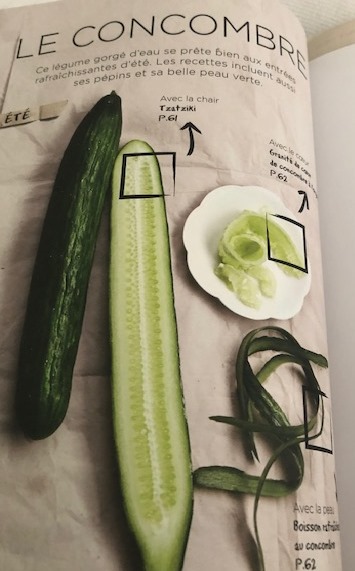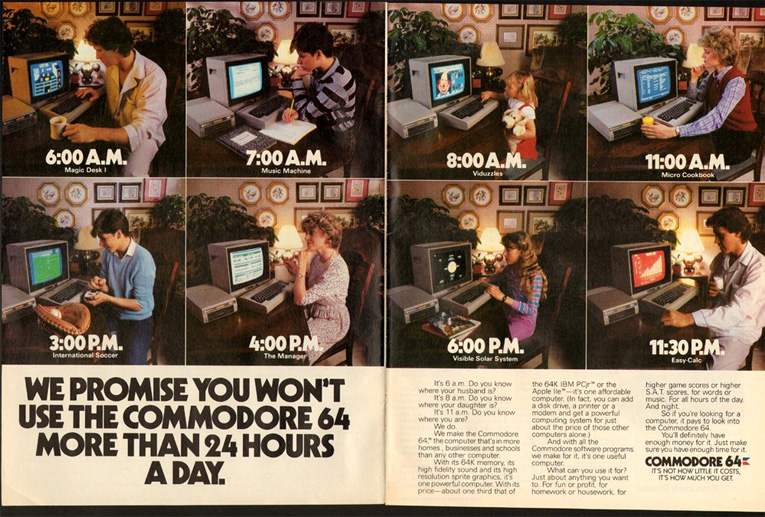DEUTSCHE VERSION NACH DEM ENGLISCHEN TEXT
Many good things have an expiration date. At the beginning of the 1980s Commodore launched the C-64. It was THE measure of all things in home computers, as on could use it as text editor, for programing, playing games and many more things and store everything on 5 ¼ inch floppy disks. More elaborate users even had a compuserve e-mail account and dialed into the wide world of the Internet with the acoustic couplers and suddenly had contacts to unknown people in distant countries. A privilege that had previously been reserved for CB radio operators. The texts were printed with the Epson dot matrix printer on green-white striped continuous paper, which with its double-sided perforated edges rose like a sluggish snake out of a large cardboard box.
Today the 64 kilobytes of the C-64 are not even enough to store a mobile phone photo. The iphone doesn’t fit properly into the shells of the acoustic coupler and our children can admire floppy disks, dot matrix printers and co in the museum next to the first light bulb and the Ford Model T and shortly after the grave goods from the Egyptian pharaoh graves.
In contrast to the C-64, the food in the supermarket has an expiry date printed on it. However, this serves the protection of the seller and not the buyer. After this date, the seller no longer has to take responsibility for the taste characteristics and it is the buyer’s own responsibility how long he still wants to eat it. This period might be shorter for a tiramisu prepared with fresh eggs than for a vintage port wine 😉
When I stroll through the city today, I sometimes ask myself whether the concept of personal responsibility has reached its expiry date as well? In the tram I am instructed that I should first let people get out, in the restaurant toilet I am told that I should please leave it as I would like to find it and in the shopping mile every garbage bin tells me that he would be happy if I did not throw my garbage on the street.
So I shouldn’t have been surprised what happened to me the other day in the cheese department of my favourite French shop. I dreamed of Adrian and my ideas for the big holidays. As it is the case with dreams, one is torn out; whether by alarm clocks or fellow men. A woman, a generation older than me, barks at me in bumpy French with a heavy German accent if I know why these hard cheeses are not sold at a reduced price or why they have not already been eliminated. “Look, it says 2.8. or 31.7”. I explain to her that this is not the expiration date, but the packaging date. I politely withhold the comment that not all mouldy cheese is thrown away in France 😉
I am not a fan of the “from nose to tail” concept. For me, giblets belongs in cat food. But a few weeks ago I bought a French cookbook with the nice title “Zéro Déchet – 120 Recettes sans rien jeter (vraiment rien!)” in English: “No waste; 120 recipes without waste (really none)” and found inspiring ideas in it. The purpose of this great cookbook is to consciously deal with the whole fruit, vegetables, fish, chicken or beef etc. while cooking. To cook without waste or to use everything.
In addition to recipe ideas for the meat of a chicken, this contains ideas for what could be done with the skin, e.g. baking chips in the oven or using them to grease trays. The chicken feet and bones are perfect for making chicken stock.

Or the cucumber: Tzatziki is made from the seeds, and the “cucumber flesh” is used to make either a granitée together with Fleur d’Oranger. Or puree it, add 3dl Ayran and a deliciously cool summer drink is ready. Or add a handful of peppermint leaves, 2dl water and a teaspoon of cane sugar to the cucumber peel. Whisk it, put it in the fridge and and you have a nice Sorbet.

The whole book was a revelation to me. For a long time I didn’t know that it was possible to eat the cabbage from the cauliflower or the peel of my beloved fava beans, which can also be cut into small pieces and roasted on a tin for an aperitif. Anyway, I began to take myself by the nose and now try to expand my culinary art on the basis of these impressions.
Recently I cooked “stuffed tomatoes” for my adult children, one of our summer favourites. For 12 tomatoes you fry 600g minced meat, season with pepper, salt, mayoran, thyme and the seed juice of the hollowed out tomatoes. Add a large tablespoon of flour to prevent the sauce from becoming too liquid. I cut two Mozzarella into slices or crumble 300g Feta and fill the bottom of the tomatoes with it and add the minced meat. Then add a large amount of grated hard cheese and the lid of the tomato. Baked at 220 degrees with circulating air for about 15 minutes.
Yes and now it comes: I peppered and salted the hollowed out tomato flesh strongly, added 3dl Ayran and mixed everything together. We drank it as an aperitif before the rosé from Provence.
In the future I will always consider while cooking whether and how the “waste” can still be used. However, absolutely Zero Waste Cooking seems to me to be quite a challenge when I think, for example, of banana peels, fishbones or the spikes of sea urchins.
Enjoy, Susann and Adrian
Von Akustikkopplern, Ablaufdaten und Zero Waste Kochen
Viele gute Dinge haben ein Verfalldatum. Anfangs der 1980er Jahre brachte Commodore den C-64 auf den Markt. Dieser war das Mass der Dinge bei den Heimcomputern, da man damit nicht nur Texte bearbeiten sondern auch programmieren und Spiele spielen und alles auf 5 ¼ Zoll Floppy Disks speichern konnte. Gewieftere Benutzer hatten sogar einen compuserve e-mail Account und wählten sich mit dem Akustikkoppler in die weite Welt des Internet ein und hatten plötzlich Kontakte zu unbekannten Menschen in fernen Ländern. Ein Privileg, welches bis dahin den CB Funkern vorbehalten war. Die Texte wurden mit dem Epson Nadeldrucker auf grün-weiss gestreiftes Endlospapier gedruckt, das mit seinen beidseitig gelochten Rändern einer trägen Schlange gleich aus einem grossen Karton hervorstieg.
Heute reichen die 64 Kilobyte des C-64 nicht einmal um ein Handyfoto zu speichern. Das iphone passt irgendwie nicht richtig in die Muscheln des Akkustikkopplers und Floppy Disks, Nadeldrucker und co können unsere Kinder im Museum neben der ersten Glühlampe und dem Ford Model T und kurz nach den Grabbeigaben aus den ägyptischen Pharaonengräbern bewundern.
Im Gegensatz zum C-64 steht bei den Lebensmitteln im Supermarkt ein Ablaufdatum aufgedruckt. Allerdings dient dieses dem Schutz des Verkäufers und nicht des Käufers. Nach diesem Datum muss der Verkäufer nicht mehr Verantwortung für die geschmacklichen Eigenschaften übernehmen und es liegt in der Eigenverantwortung des Käufers, wie lange er mit dem Verzehr noch zu wartet. Dies mag bei einem mit frischen Eiern zubereiteten Tiramisu wohl kürzer sein als bei einem Jahrgangs Portwein.
Wenn ich heute durch die Stadt bummle so frage ich mich allerdings manchmal, ob auch das Konzept der Eigenverantwortung ihr Ablaufdatum erreicht hat? Im Tram werde ich belehrt, dass ich zuerst die Leute aussteigen lassen soll, in der Restaurant Toilette teilt man mir mit, dass ich diese bitte so verlassen soll, wie ich sie gerne antreffen würde und in der Shopping Meile teilt mir jeder Abfallkübel mit, dass er sich freuen würde, wenn ich meinen Müll nicht auf die Strasse werfe.
Insofern hätte es mich eigentlich nicht wundern sollen, was mir neulich in der Käseabteilung in meinem französischen Lieblingsgeschäft widerfahren ist. Ich träumte in einer Kopfreise Adrians und meine Ideen für die grossen Ferien. Wie es mit Träumen halt so ist, man wird herausgerissen; ob von Weckern oder Mitmenschen. Jedenfalls spricht mich eine Frau, eine Generation älter als ich, in holprigem Französisch und mit deutschem Akzent an. Sie fragt mich erbost ob ich wisse, weshalb diese Hartkäse nicht zum reduzierten Preis verkauft würden bzw. nicht bereits eliminiert worden waren. „Schauen Sie, da steht 2.8. oder 31.7“. Ich kläre sie auf, dass es sich dabei nicht um das Ablaufdatum handelt, sondern um das Einpackdatum. Den Kommentar – dass man in Frankreich nicht alle schimmligen Käse wegwirft – konnte ich mir knapp verkneifen 😉
Ich bin an und für sich kein fan des „from nose to tail“ Konzepts. Innereien gehören für mich ins Katzenfutter. Ich kaufte jedoch vor ein paar Wochen ein französisches Kochbuch mit dem schönen Titel „Zéro Déchet – 120 Recettes sans rien jeter (vraiment rien!)“ auf Deutsch: „Kein Abfall; 120 Rezepte ohne Abfälle (wirklich keine)“ und fand darin inspirierende Ideen. Der Sinn und Zweck dieses grossartigen Kochbuchs ist, sich bewusst mit der ganzen Frucht, Gemüse, Fisch, Poulet oder Rind etc. kochend auseinander zu setzen. Ohne Abfälle zu kochen bzw. alles zu verwerten. Neben Rezeptideen für das Fleisch eines Poulets enthält dieses Ideen, was man mit der Haut machen könnte, zB im Ofen zu Chips backen oder zum Einfetten von Blechen verwenden. Die Hühner-Füsse und -Knochen eignen sich wunderbar zur Herstellung von Hühnerbouillon.

Oder die Salatgurke: Aus den Kernen gibt’s Tzatziki, aus dem „Gurken-Fleisch“ stellt man entweder eine Granitée zusammen mit Fleur d’Oranger her oder püriert es, gibt 3dl Ayran dazu und fertig ist ein herrlich kühles Sommergetränk. Die Gurkenschalen kann man mit einer grossen Handvoll Pfefferminzblätter, 2dl Wasser sowie einem Kaffeelöffel Rohrzucker mixen und dann gefrieren, was ein wunderbar erfrischendes Wassereis ergibt.

Das ganze Buch war für mich eine Offenbarung. Ich wusste vorher nicht, dass man auch vom Blumenkohl das Kraut essen kann oder die Schale meiner heissgeliebten Favabohnen. Letztere z.B. kleingeschnitten auf dem Blech geröstet zum Apèro. Von der Lektüre inspiriert, begann ich zu tüfteln.
Kürzlich kochte ich für meine erwachsenen Kinder „Gefüllte Tomaten“, einer unserer Sommerlieblinge. Ich löse das Fruchtfleisch von 12 Tomaten aus und brutzle dann 600g Hackfleisch an und würze dieses mit Pfeffer, Salz, Majoran, Thymian sowie dem Kernensaft der Tomaten. Gibt einen grossen Esslöffel Mehl hinzu damit die Sauce nicht zu flüssig wird. Ich schneide zwei Mozzarella in Scheiben oder zerbröckle 300g Feta und fülle damit den Boden der Tomaten und gebe das Hackfleisch hinzu. Danach kommt eine grosse Menge geriebener Hartkäse darüber und der Deckel der Tomate. Gebacken bei 220 Grad mit Umluft während ca. 15 Minuten. Ja und jetzt kam die Inspiration: Das verbleibende Tomatenfleisch pfefferte und salzte ich kräftig, gab 3dl Ayran dazu und mixte alles kurz mit dem Stabmixer und stellte es kühl. Wir tranken es zum Aperitif vor dem Rosé aus der Provence.
In Zukunft werde ich mir nun beim Kochen stets Gedanken machen, ob und wie man die „Abfälle“ noch verwerten kann. Absolutely Zero Waste scheint mir allerdings eine ziemliche Herausforderung zu sein, wenn ich z.B. an Bananenschalen, Fischgeräte oder die Schalen von Seeigeln denke 😉
Guten Appetit, Susann and Adrian



